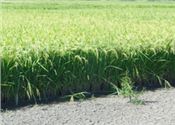|
New Rice Growing Plan Uses Same Weed Control

Whether grown under a conventional system or the newer alternating wet and dry method,
weeds are controlled in rice during the initial 21-day continuous flood the crop needs to
get established.
Photo by MSU Extension Service/Lee Atwill
STARKVILLE, MISS.
Growing rice on fields that are alternating wet and dry is gaining popularity across Mississippi as producers learn they can effectively control weeds under this nontraditional system.
Alternating wet and dry rice management is a way to grow rice that saves water and money, while producing the same yields.
Lee Atwill, a Mississippi State University Extension Service associate and agronomy doctoral student, researched weed control in conventional rice growing conditions and in the alternating wet and dry method, or AWD. The conventional method of growing rice uses a continuous flood over the paddy. AWD allows fields to dry out before farmers flood them again.
“Barnyard grass is the worst weed in rice, and it causes the most economic damage and problems,” Atwill said. “Management of that grassy weed is our No. 1 goal in weed management in rice.”
Atwill found that rice fields are managed exactly the same for weeds up until 21 days after the initial flood is established. This finding is true of both conventional and Clearfield rice – which is hybrid rice bred for particular traits – under both conventional rice growing conditions and the AWD method.
“The key to weed control in any rice management system is to start clean and stay clean,” Atwill said. “If you manage up front and are proactive in your weed control so weeds don’t get in front of you, then herbicide management and application is the same in conventional rice systems and alternating wet and dry systems.”
Jason Krutz, Extension irrigation specialist and Mississippi Agricultural and Forestry Experiment Station researcher, said this rice management system intentionally allows the rice field to dry down after the initial flood.
“We establish the flood again before harvest, so alternate between a wet and dry field,” Krutz said. “Rather than letting the rice grow in 2 to 4 inches of standing water during the majority of the growing season, we recommend letting the field dry out until the soil is dry to 4 inches deep before flooding it again.”
Krutz said about 20 percent of Mississippi farmers have used some form of AWD to date, but he wants to see that number increase.
“Using AWD, we’ve been seeing a 30 percent reduction in water use and no change in yield,” Krutz said. “The economic advantage is our AWD fields are coming in about $50 ahead from water savings.”
Although there is a money savings from using less water, Atwell said some producers worry that weeds will spring up when fields dry down. Weeds growing in rice fields reduce yields and hamper harvest, but Atwell said residual herbicides applied when the field is flooded continue to resist weed growth.
“The effectiveness of preflood application for both contact and residual herbicide remains until canopy closure,” he said. “Herbicide technology in rice has come a long way, and we’re getting better residual action than we did in the past when the chemicals are used correctly.”
While weeds are controlled the same in both rice growing systems, disease management may require some changes.
“Rice blast is the No. 1 disease of rice and is the only disease that can cause 100 percent yield loss,” Atwill said. “In a situation where blast is prevalent, growers have to bring the flood back to continue to make fungicide application as needed.”
To minimize risk of this disease, growers need to use rice varieties with blast resistance. ∆
|
|